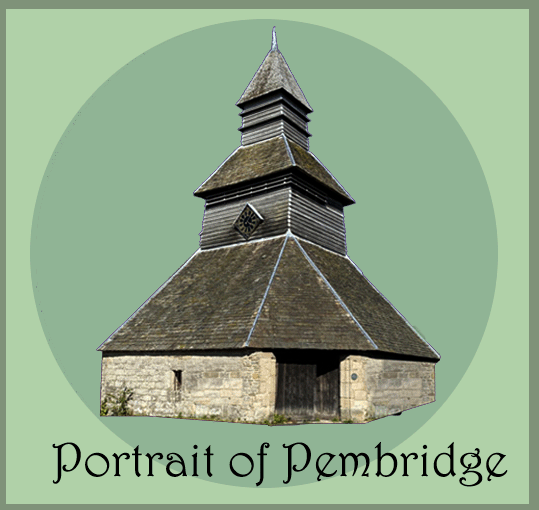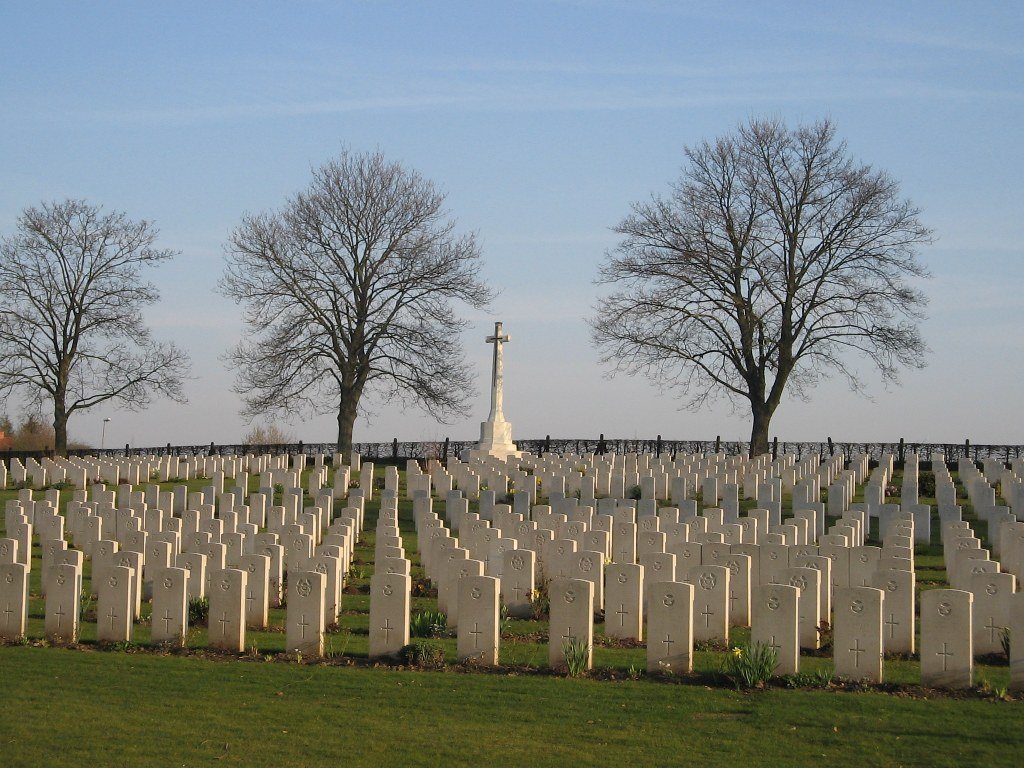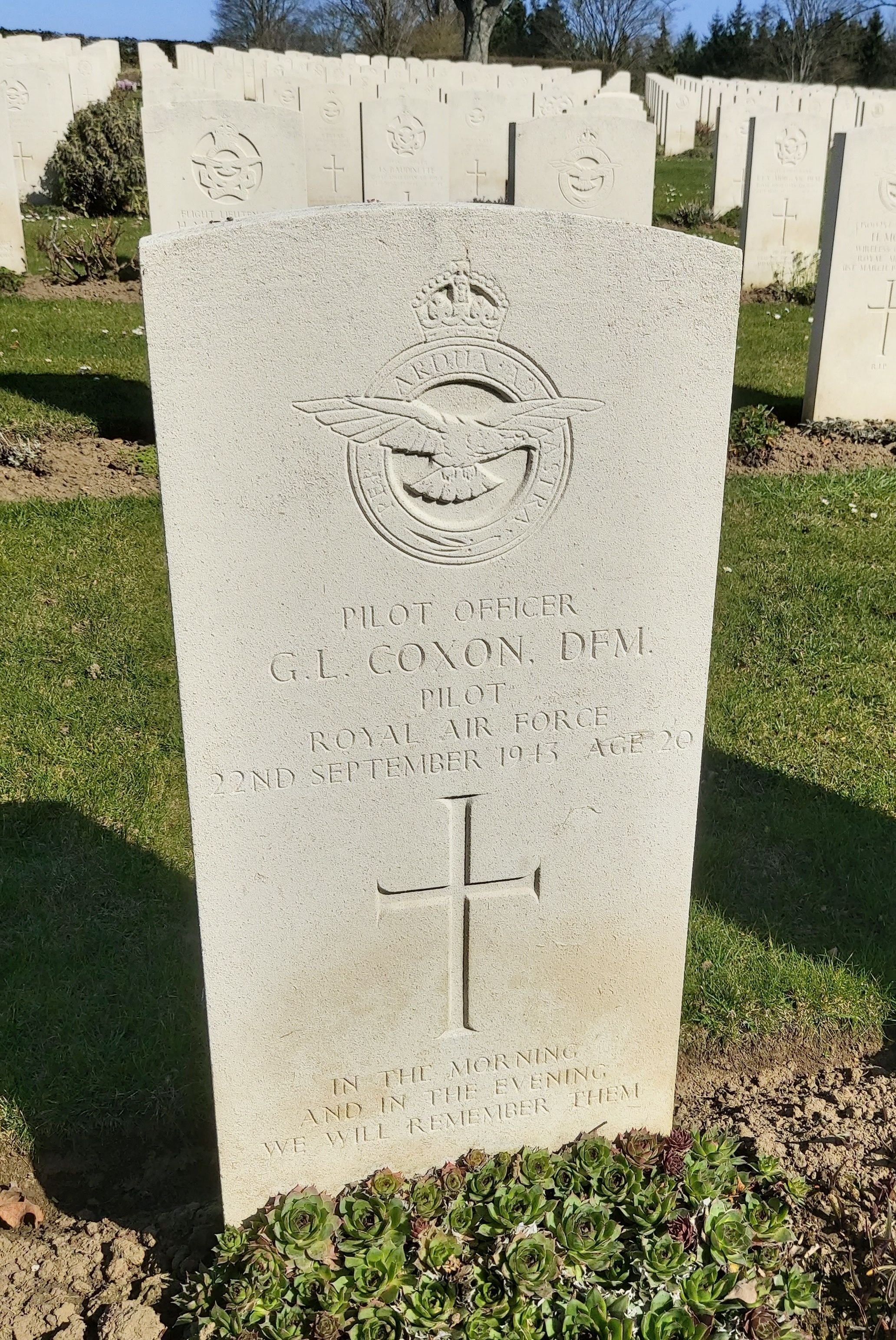Geoffrey Lewis Coxon, Sergeant, Royal Air Force Volunteer Reserve
Above photo: Geoffrey Coxon (1)
Geoffrey Coxon was born in Kington in 1923.
Geoffrey’s grandfather was Charles Coxon who, in the 1891 census, was a farmer and land agent.
Above photo: Charles Coxon (2)
In the 1891 census, Charles Coxon was residing at Elford Park, Shropshire with his wife, two daughters and one son, Charles Lewis Coxon, who was born in 1882. Six servants also resided at the property.
Above photo: Elford Park (3)
In the 1901 census, Geoffrey Coxon’s father, Charles, aged eighteen is still residing at Elford Park. He is described as “relative's son worker”.
In 1904, Charles Lewis Coxon marries Agnes Heathcote Lowe (born 1878) who was also from Elford. In the 1901 census she had been living at her father’s residence in Elford and worked as “a governess at school”.
By 1911, Charles Lewis Coxon is residing at Webton Court, Madley, Herefordshire.
Above photo: Webton Court, Madley (4)
Charles Lewis Coxon is described as “farmer employed at home”. He is the only person registered as living at this 12-room property. This is due to the fact that his wife and two children were registered as “visitors” at a property in Tarrington, Herefordshire on the day the census was taken.
The 1939 England and Wales Register states that Charles Lewis Coxon is now living at Milton, Pembridge. He is a “dairy and mixed farmer” while his wife and younger son, John Coxon are residing near Chipping Sodbury in South Gloucestershire. Both Charles Lewis Coxon and Agnes Coxon are still married.
Below is a photo of Alice Coxon (second right), Geoffrey’s older sister. It was taken on the day of her marriage to Eric Payne in 1937. The man on the right in the photo bares a striking similarity in physical features to Geoffrey Coxon’s grandfather in photo ‘2’ above. So, it might well be that this man was Geoffrey’s father, Charles Lewis Coxon and the woman on the far left was his mother, Agnes.
Above photo: Alice Rosemary Coxon marries Eric Payne (5)
It is difficult to ascertain where Geoffrey Coxon, aged 16, was in 1939 but it is possible, given his age, that he would have been attending a boarding school and thus is not on the 1939 register at his mother’s or father’s address.
When war was declared on September 3rd of that year, parliament enacted The National Services (Armed Forces Act). This act enforced full conscription on all male British subjects between 18 and 41 who were present in Great Britain subject to certain exemptions.
Geoffrey Coxon, having been born in the first three months of 1923, would not have been eligible for conscription until January 1941 at the earliest. What is known is that he joined the Royal Air Force Volunteer Reserve.
“The Royal Air Force Volunteer Reserve was established in 1936 to support the preparedness of the U. K. Royal Air Force in the event of another war. The Air Ministry intended it to form a supplement to the Royal Auxiliary Air Force, the active reserve for the RAF, by providing an additional non-active reserve.
However, during the Second World War, the high demand for aircrew absorbed all available Royal Auxiliary Air Force personnel and led the Royal Air Force Voluntary Reserve to quickly become the main pathway of aircrew entry into the RAF. It was initially composed of civilians recruited from neighbourhood reserve flying schools, run by civilian contractors with largely RAF-trained flying instructors as well as other instructors in related air war functions, such as observers and wireless operators”. By the end of 1941 more than half of Bomber Command aircrew were members of the Royal Air Force Volunteer Reserve.” (Wikipedia)
When war was declared “the risk of Luftwaffe attack on training bases in Great Britain coupled with the urgent need for larger numbers of well-trained aircrew than the pre-war systems could produce brought about the British Commonwealth Air Training Plan.” (Wikipedia)
This was often referred to as “The Plan”. “It was a massive, joint military aircrew training program created by the United Kingdom, Canada, Australia and New Zealand, during the Second World War.” (Wikipedia)
“The bomber war was fought largely by young, civilian volunteers from Britain and the Commonwealth, commanded by men who joined up before the Second World War. The vast majority of aircrew were in their late teens or early twenties. Only 25% were officers.” (IWM).
“On completion of basic military, training aircrew candidates would wear a white flash on the front of their service issue "side caps" denoting their "aircrew under training" status. No matter where they originated in Britain or the Commonwealth, they could be shipped to the next available training course in any of those nations where pilots were trained to fly at "Elementary Flying Training Schools" and the other aircrew trades attended appropriate trade schools such as "Air Navigation Schools" or "Bombing and Gunnery Schools". Following completion of training at a graduation ceremony, aircrew were presented with their aircrew brevet (the correct term is flying badge) and either handed their sergeant's stripes or commissioned as officers.” (Wikipedia)
Geoffrey Coxon was promoted to the rank of sergeant and posted to 207 Squadron as a pilot at RAF Bottesford on the Leicestershire/Lincolnshire border.
Above photo: RAF Station Bottesford, crew of a Lancaster Aircraft (AWM)
“The pilot of a bomber crew flew the aircraft throughout the operation and coordinated the actions of the other crew members. He was the captain of the aircraft regardless of his rank (in relation to other crew members) and the most important crew member. He was responsible for the lives of all the crew and the aircraft whilst in the air. If an emergency evacuation of the aircraft was necessary, the pilot had to stay at the controls and be the last to leave.” (IWM)
Above photo: The pilot of a Handley-Page Halifax of No. 35 Squadron in his position prior to take-off at
Linton-On-Ouse, Yorkshire (IWM)
Above photo: 207 Squadron: The ninth person from the right in the back row might well be Geoffrey Coxon (6)
In November 1942, Geoffrey Coxon, along with 207 Squadron, was posted to RAF Langar, Nottinghamshire, owing to the Bottesford runway surface breaking up and needing urgent repairs.” (Wikipedia)
Above photo: RAF Langar, September 1943 (Wikimedia)
By this time, the squadron, having flown, for the first two years of the war, in The Handley Page Hampden, were now flying the Avro Manchester.
Above photo: Avro Manchester 1 (Wikipedia)
“The Avro 679 Manchester was a British twin-engine heavy bomber developed and manufactured by the Avro aircraft company in the United Kingdom. While not being built in great numbers, it was the forerunner of the famed and vastly more successful four-engined Avro Lancaster, which was one of the most capable strategic bombers of the Second World War.” (Wikipedia)
“In November 1940, the Manchester officially entered service with the newly reformed No. 207 Squadron of RAF Bomber Command. The type passed all acceptance tests by 21 December 1940 and by the end of 1940, 207 Squadron had at least 80 Manchesters on strength.
207 Squadron was” the first British squadron used solely for long-range night bombing.
“The squadron took the Manchesters on their first raid of the war on 24/25th February 1941, when six aircraft attacked a Hipper-class cruiser at Brest.” (7)
Above photo: The forward section of an Avro Manchester Mark I of No. 207 Squadron RAF, while running up the port Rolls-Royce Vulture II engine at Waddington, Lincolnshire, showing the nose with the bomb aimer's window, the forward gun-turret and the pilot's cockpit (IWM)
“Aircrew were first committed to a tour of thirty operational flights, not exceeding 200 actual flying hours, which could last for any period from four months to a year.
The everyday lives of most aircrew, unlike other servicemen, were a unique mixture of danger and normality. At one moment the men were on a bombing raid, a few hours later they were safely at home in the pub.
Bomber operations were extremely stressful and frequently perilous, with a random chance of death or horrific injury. Flying was physically and mentally demanding and constant concentration was needed for many hours at a time. Airmen had to not only fight the enemy, but also a hostile environment in which they might encounter many kinds of adverse weather. Occupational hazards such as lack of oxygen, frostbite and lower pressures at high altitude meant they needed equipment to keep them warm and breathing. These problems were increased by operating at night.
On operations, most aircrew feared anti-aircraft fire, known as flak, although statistically, they were more likely to be shot down by fighters. Shrapnel from exploding flak could cause extensive damage not only to aircraft, but also to the crew. It could result in serious injuries, especially if it struck the head or upper body. The sight and sound of shells bursting nearby were unnerving to an aircrew and a near miss could cause the aircraft to jolt alarmingly.
For aircrew returning safely from an operation, relief at survival was the overriding emotion. Once home they could enjoy a hot meal and a sleep in a warm bed.
Above photo: An exhausted young Canadian pilot after returning from an operation over Germany (IWM)
For the next few days there might be no flying. RAF stations generally had good leisure facilities and there were frequent dances, mess parties and variety shows. Aircrew were given generous amounts of leave, with a seven-day pass every six weeks and shorter periods granted during prolonged bad weather or after difficult operations.” (IWM)
Above photo: Two Avro Lancaster B Mark 1s based at RAF Bottesford, Lincolnshire in flight (IWM)
In the “UK, WWII, Recipients of The Distinguished Flying Medal, 1939-1945”, the following was published.
On September 22nd, 1943, the Lancaster bomber that Geoffrey Coxon was piloting was shot down over Germany.
According to The International Bomber Command Centre Losses Database, the following was recorded.
“AIRCRAFT INFORMATION
Aircraft, Avro Lancaster lll
Serial Number, ED442
Markings, EM-W
LAST OPERATION INFORMATION
Start Date, 22-09-1943
End Date, 23-09-1943
Takeoff Station, Langar
Day/Night Raid, Night (34% moon)
Operation, Hannover
Reason for Loss, Hit by flak and crashed Bad Mϋnder. All eight crew killed” (8)
Geoffrey Coxon was aged 20.
He is buried at Hanover War Cemetery, Germany.
Above photo: Hanover War Cemetery (CWGC)
The cemetery contains 2,407 Commonwealth burials of the Second World War, 62 of them unidentified.” (CWGC)
Geoffrey Coxon’s headstone is engraved with the words “IN THE MORNING AND IN THE EVENING WE WILL REMEMBER THEM”.
Above photo: Geoffrey Coxon’s grave and headstone (9)
At the time of his death, Geoffrey Coxon’s home residence was at Hambrook, Bristol where both his parents were also living.
Above photo: Hambrook, Bristol, circa 1920s (10)
Geoffrey Coxon left the sum of £568 16s 9d to his mother, Agnes Coxon.
Geoffrey Coxon’s father died in 1962. At the time of his death, he was residing at Dower House, King’s Pyon, Herefordshire. In his will, he left to Sarah Mary Coxon (his widowed daughter), Charles Henry Coxon, farmer and John Coxon, farm manager, the sum of £43,769 1s which in today’s money is worth approximately £1,200,00.
Geoffrey Coxon’s mother had died in 1956 at The Royal County Hospital, Winchester. In the England and Wales National Probate (Index of Wills and Administrations) it states that Agnes Coxon, at the time of her death, had been residing at 71 Stockbridge Road, Winchester. She left £4,155 1s 10d to her daughter Alice Rosemary Payne Moxon (pictured in photo ‘5’ above).
It is interesting to note that of the three men commemorated on the Pembridge War Memorial who were in the RAF during the 2nd World War, two of these men were in the same RAF squadron – 207. Given that there were 96 British RAF squadrons during the 2nd World War, the chances of both men being in the same squadron would have been slightly more than 1 per cent.
Rory MacColl
Sources
1/ ancestry.co.uk
2/ ancestry.co.uk
3/ www.parksandgardens.co.uk
4/ https://historicengland.org.uk/listing/the-list/list-entry/1302246
5/ ancestry.co.uk
6/ http://www.207squadron.rafinfo.org.uk/news_fp.html
7/ https://vwma.org.au/explore/units/846
8 / https://www.losses.internationalbcc.co.uk/loss/105124/
9/ https://www.findagrave.com/memorial/18584147/geoffrey-lewis-coxon
10/ https://www.pinterest.co.uk/pin/386746686743001500/


















